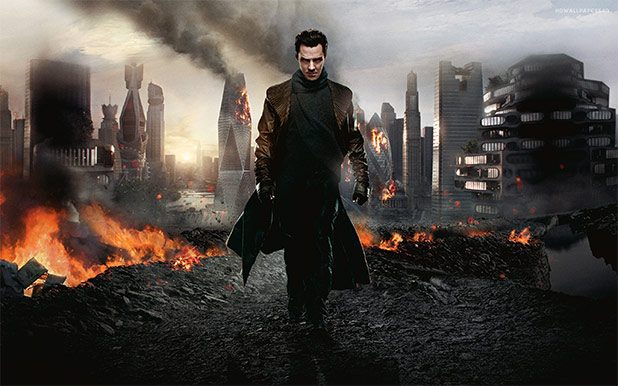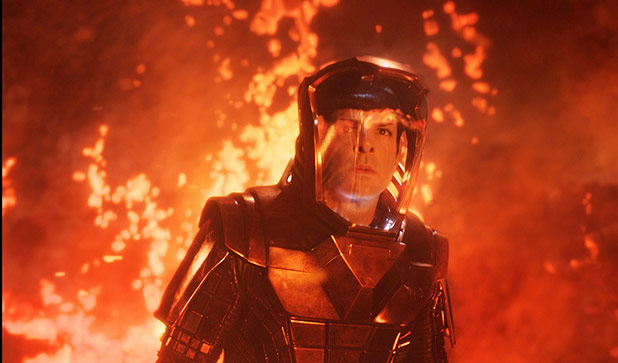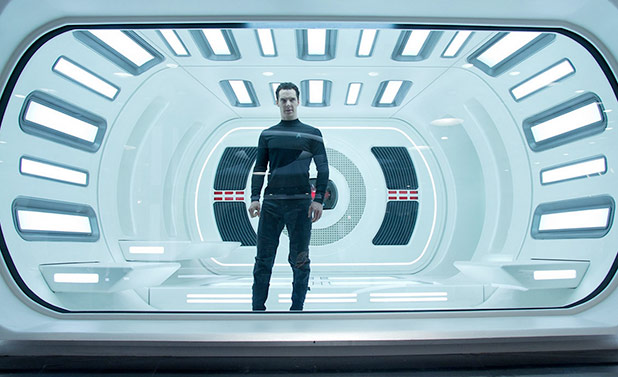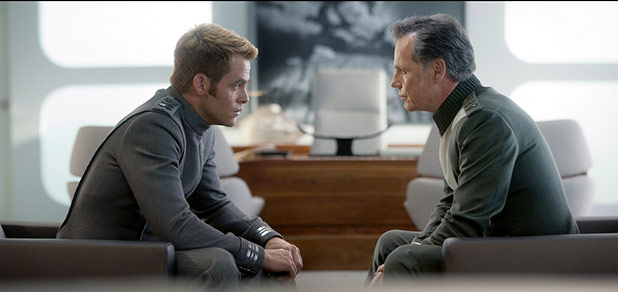The Art of Boldly Going Where Trek Has Gone Before: Why STAR TREK INTO DARKNESS Succeeds at Reopening Old Wounds [SPOILERS]

[WARNING! SPOILERS AHEAD]
About three weeks before STAR TREK INTO DARKNESS (STID) was released in the U.S., I shamelessly tracked down posts on Trek message boards for any single spoiler review following the initial press screenings. I wanted to know the truth behind everything: John Harrison, whether the Enterprise is destroyed and what about those pesky Klingons?
I got a lot more than I expected from a couple of reviews that gave excruciatingly detailed scene-by-scene breakdowns of the entire film. As I scanned the posts, my eyes began to widen at the most unbelievable (and at the time unforgiveable) revelations: Kirk dies saving the Enterprise, the death scene from THE WRATH OF KHAN (TWOK) is reversed and Spock screams Khan. I declared this movie a complete failure in that moment.
I kept this knowledge to myself among my friends. I was committed to see this disaster regardless of what I had read; I purchased my advance tickets in February, I never missed a STAR TREK movie in the theaters since I was old enough to decide I wanted to see STAR TREK (for the record, STAR TREK III: THE SEARCH FOR SPOCK rocked my seven year-old brain). I gave up hope for this film and I had negative expectations going in.

Flash forward to the night of the screening. As soon as the lights lowered and Michael Giacchino’s now well-worn NuTrek theme began to usher the many production company logos, I was already beginning to warm up to this film. This is STAR TREK, the single favorite thing I’ve ever known in terms of entertainment/mythology. I don’t fool myself into thinking it’s good when it’s terrible. I just always find a way to enjoy myself when I see new STAR TREK. So, lighten up, I said to myself. Enjoy this for whatever it ends up being.
As the Enterprise crew comically attempts to avoid violating the Prime Directive whilst saving Nibiru, I was completely engrossed. Here we are, watching the crew of the Enterprise improvising on a strange, new world. Director J.J. Abrams and his stable of screenwriters (Bob Orci, Alex Kurtzman and Damon Lindelof) resuscitate the fun of space exploration in a handful of minutes. When was the last time STAR TREK was fun? I know this movie is called INTO DARKNESS (and we’ll get to that soon) but I am so relieved that I get to see my “space family” alive and kicking in a dazzling opening sequence- a sequence that ends on a perfect note with Kirk dismissing the Prime Directive “violation” while the Nibirans have embraced the Enterprise as their new God. Please tell me this will figure into a future TREK film!
At this point, I stopped caring about how this film was going to rip off TWOK. I was more focused on the performances by Chris Pine, Zachary Quinto, Bruce Greenwood and Simon Pegg. These actors are all engaging, earnest and fresh in their roles. One of the most moving scenes in particular was between Pike and Kirk at the dive bar following Kirk’s demotion to Academy cadet from Starfleet Captain. Pike shows up to console Kirk and you can see this healing taking place on Kirk’s face, as if all those years of growing up without a father were fading behind him thanks to Pike’s love. Chris Pine’s subtle performance here shows Kirk’s vulnerability in a way William Shatner has never delivered. Look, I love Shatner- I have a shrine built to him in my office (seriously) but Chris Pine is taking Kirk into new territory without betraying the true character’s nature. This is where the reboot succeeds the most in these two films, by giving us familiar icons in a new context (and a new continuity, therefore freeing them to do new things). Oh wait, about that…

Benedict Cumberbatch is John Harrison who is really Khan. Damn it, Bad Robot, damn it, damn you all! You created a new timeline, kicked continuity in the balls by destroying Vulcan and turning Kirk’s eyes blue- you have this whole franchise by the tail and what do you do? The lazy thing, you bring back Khan and have him try to kill Kirk and his crew when it was done over 30 years ago by the best of the TREK films. Why?
I didn’t get an answer to that question until I watched Jim Kirk die. Seeing Kirk experience his best friend’s sacrifice through his own act of selflessness was probably the most poignant moment I’ve experienced with these characters since Shatner said “Second star to the right… and straight on ‘til morning” to close out the Original Crew’s run in STAR TREK VI: THE UNDISCOVERED COUNTRY. The echoes of TWOK’s dialogue from the reactor core scene were touching and the lines carried emotional weight because they revealed the true brotherhood between Kirk and Spock. Kirk even said “… this is what you would have done, it was only logical.” He doesn’t need to finish the sentence because we all know what comes next. The audience is now aware of what Kirk has come to understand, perhaps for the first time in any timeline, that the needs of the many outweigh the needs of the few- or the one. Furthermore, there is such a thing as the no-win scenario. I’m not sure that Shatner’s Kirk ever truly understood this lesson, and I love the bastard for being so stubborn. In this NuTrek universe, Kirk is a different man based on the events in this film. He loses his ship, his father/mentor, his faith in superiors, his self-confidence and even his life. He tells Spock that he doesn’t know what he’s doing and that the ship needs someone that does know what they’re doing, and that person is Spock. This is a significant new direction for Jim Kirk. I like this version quite a bit.
And so, here’s why repeating (or plagiarizing) previous movies works for STID- it’s only through these parallels that we can truly evaluate the new directions being taken by these beloved characters. Before seeing this film, I complained that rehashing Khan was a lazy, cynical choice by the filmmakers. I just want the Enterprise to get out into space and go exploring or something. Where’s my old STAR TREK? What I didn’t understand is that these films are exploring the characters. Why go back to the Original crew if the characters are the same exact people but played by lookalike actors? There’s nothing truly interesting in that scenario, all you’re doing is evaluating the actors’ skill at imitating their predecessors.

STID taught me that the creative drive with this series is to revisit these heroes through a new, transparent derivation. New situations reveal new traits and old ones too for each member of this gallant crew. I still think Khan was a dull choice, and I do not find Benedict Cumberbatch a compelling Khan or villain for that matter. The real payoff for me was what I discuss above- seeing Kirk and Spock switch places to further their bond between them and us, the audience. I know a lot of people hate this choice and wished for something innovative plot-wise (like Khan saving the Enterprise to save his people, making him sympathetic) but all of that misses the point of this and the previous film. NuTrek is about the Original crew, not the secondary characters, aliens, ships or any of that other stuff. In this “what if?” universe, the writers wanted to test the audience by taking the most famous and emotional scene in the show’s history and repackage it to serve their purposes. It wasn’t a lazy choice like I had originally thought, it was an ambitious choice meant to challenge the core audience to see the heroism of these characters by showing the pattern of their acts, values and words.
STID is a love letter to STAR TREK. The film devotes its energy to the main characters, warmly showing us anew why they matter almost 50 years later. So, by going over old tracks, STID showed me a lot of new things about my heroes. I am grateful for being proven wrong, and for having the chance to appreciate the bold, thoughtful decision to bring TREK back to its emotional roots for this film.

